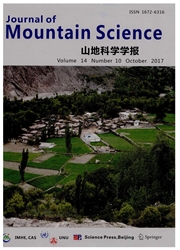

 中文摘要:
中文摘要:
叶区域索引(LAI ) 是在植被分析和管理的一个关键参数,特别为山区。LAI 的精确检索基于遥感数据是很必要的。在在在 Gansu 省的 Heihe 分水岭的 Dayekou 森林中心的研究,我们基于 SPOT-5 的地志的修正决定了 LAI。除了当 orthorectification,放射刻度和大气的修正被使用时,在山地面的大变化要求了 SPOT-5 图象的预处理。这些要求了表面反射和几个植被索引和连接的获得回答测量 LAI 价值。统计回归模型被用来连接 LAI 和植被索引。在 LAI 和 SAVI (L=0.35 ) 之间的二次的多项式模型就 R 和 R2 价值而言作为最佳的模型被决定。一个秒组 LAI 数据被保留验证检索结果。模型被使用在区域创造 LAI 的一张分发地图。有一幅未改正的 SPOT-5 图象的比较证明地志的修正为在山区的 LAI 的决心是必要的。
 英文摘要:
英文摘要:
Leaf Area Index(LAI)is a key parameter in vegetation analysis and management,especially for mountain areas.The accurate retrieval of LAI based on remote sensing data is very necessary.In a study at the Dayekou forest center in Heihe watershed of Gansu Province,we determined the LAI based on topographic corrections of a SPOT-5.The large variation in the mountain terrain required preprocessing of the SPOT-5 image,except when orthorectification, radiation calibration and atmospheric correction were used.These required acquisition of surface reflectance and several vegetation indexes and linkage to field measured LAI values.Statistical regression models were used to link LAI and vegetation indexes.The quadratic polynomial model between LAI and SAVI (L=0.35)was determined as the optimal model considering the R and R2 value.A second group of LAI data were reserved to validate the retrieval result.The model was applied to create a distribution map of LAI in the area.Comparison with an uncorrected SPOT-5 image showed that topographic correction is necessary for determination of LAI in mountain areas.
 同期刊论文项目
同期刊论文项目
 同项目期刊论文
同项目期刊论文
 Extraction of forest structural parameters based on the intensity information of high-density airbor
Extraction of forest structural parameters based on the intensity information of high-density airbor Response of vegetation activity dynamic to climatic change and ecological restoration programs in In
Response of vegetation activity dynamic to climatic change and ecological restoration programs in In Estimation of chlorophyll-a concentration in coastal waters with HJ-1A HSI data using a three-band b
Estimation of chlorophyll-a concentration in coastal waters with HJ-1A HSI data using a three-band b Deriving Regional Crown Closure Using Spectral Mixture Analysis Based on Up-Scaling Endmember Extrac
Deriving Regional Crown Closure Using Spectral Mixture Analysis Based on Up-Scaling Endmember Extrac The use of HJ-1A/B satellite data to detect changes in the size of wetlands in response in to a sudd
The use of HJ-1A/B satellite data to detect changes in the size of wetlands in response in to a sudd Forest stand biomass estimation using ALOS PALSAR data based on LiDAR-derived prior knowledge in the
Forest stand biomass estimation using ALOS PALSAR data based on LiDAR-derived prior knowledge in the Retrieval of forest canopy attributes based on Geometric-Optical model using airborne LiDAR and opti
Retrieval of forest canopy attributes based on Geometric-Optical model using airborne LiDAR and opti Spatial prediction and analysis of Himalayan marmot plague natural epidemic foci in China based on H
Spatial prediction and analysis of Himalayan marmot plague natural epidemic foci in China based on H Quantitative estimation of the shrub canopy LAI from atmosphere-corrected HJ-1 CCD data in Mu Us San
Quantitative estimation of the shrub canopy LAI from atmosphere-corrected HJ-1 CCD data in Mu Us San The novel H1N1 Influenza A global airline transmission and early warning without travel containments
The novel H1N1 Influenza A global airline transmission and early warning without travel containments The retrieval of shrub fractional cover based on a geometric-optical model in combination with linea
The retrieval of shrub fractional cover based on a geometric-optical model in combination with linea 期刊信息
期刊信息
